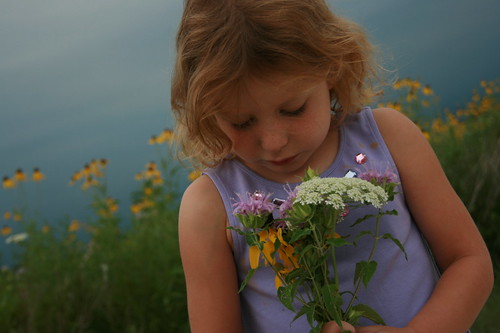My friend Felicia Akman took pictures of my kids at the Springbrook Prairie Preserve in the minutes before a powerful summer storm blew through. The effect in the photos was striking, and it was an amazing experience to feel the storm as it passed over us - and as we ran for cover.
Saturday, July 23, 2011
Pictures on the Prairie
Labels:
green kids,
prairie
Tuesday, July 19, 2011
July's Prairie Flowers as Design Inspiration
Aster (Daisy) family (Asteraceae)
Natural History: This plant, while native to Illinois, is not that common in native habitats. In fact, most of the plants that grow in the wild are escaped cultivars or as a result of prairie restoration efforts. On my ride, there were only small clusters or small groups of individuals but I was determined to collect a few for my daughter, who loves pink flowers. It has only a faint smell. The stem is strong and rigid and the seed head is heavy. The petals are smooth on top, rough on bottom, and damaged with black spots from insect or impact damage. The top of the flower head is a collection of small spines, which is why it was named after the latin name for "hedgehog." The spines are packed closely in the Fibonacci spiral formation, which allows for radiating growth.
Biomimicry Inspiration: I wonder what a seating arrangement in a restaurant, theater in the round, or other establishment where many people must be placed would look like if we tried to emulate this radiating pattern? Would its allowance for growth allow the seating arrangement to grow and contract as needed depending on how many people need to be seated? Would this pattern be relevant to temporary disaster shelter camps as well?
Labels:
biomimicry,
Garden Gossip,
Genius of Place,
iSite,
organism,
prairie
Wednesday, July 13, 2011
I fell for this tree

I went for a walk in the Morton Arboretum today, looking at tree bark. Yes, tree bark. For my biomimicry coursework, I have certain prescribed iSite assignments where I go out and observe nature. One of them included looking at tree bark and the differences between different species. This was on my mind after a conversation I had with Dr. Robert Fahey, a forest ecologist on staff at the Arboretum, about tree bark and its (marginal) insulative values. He spoke about Oak forests and how the rough bark fissures that Oak trees present actually create air pockets that help insulate the tree from fire and extreme cold. It's cork-like texture also traps air pockets, adding insulation. He was quick to mention that the cell structure of the live phloem has more to do with a tree surviving cold than the dead bark, but it was an intriguing idea for me and I resolved to contact a plant physiologist soon. Dr. Fahey spoke about the the chemistry of bark and how some species create chemicals in their bark that protect the tree from predators.
Labels:
biomimicry,
forest,
iSite,
Morton Arboretum
Subscribe to:
Comments (Atom)



